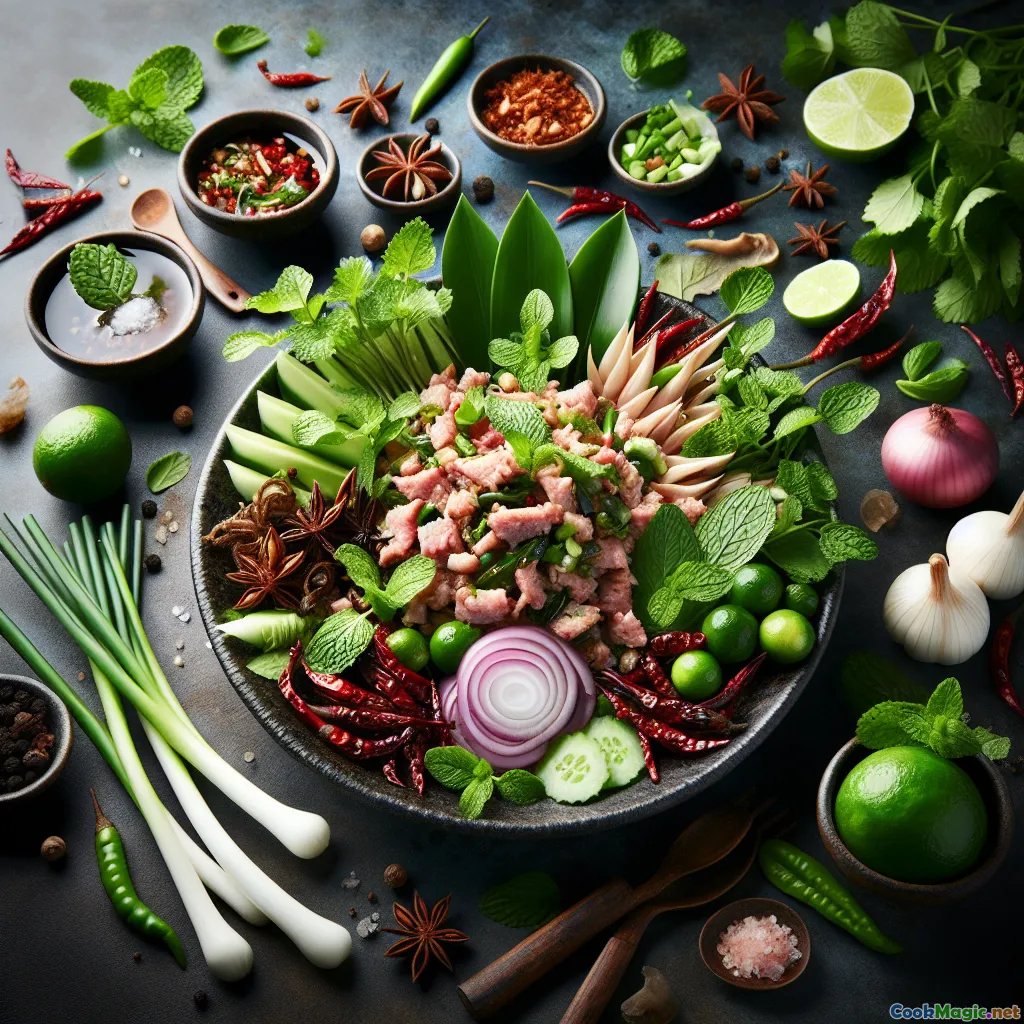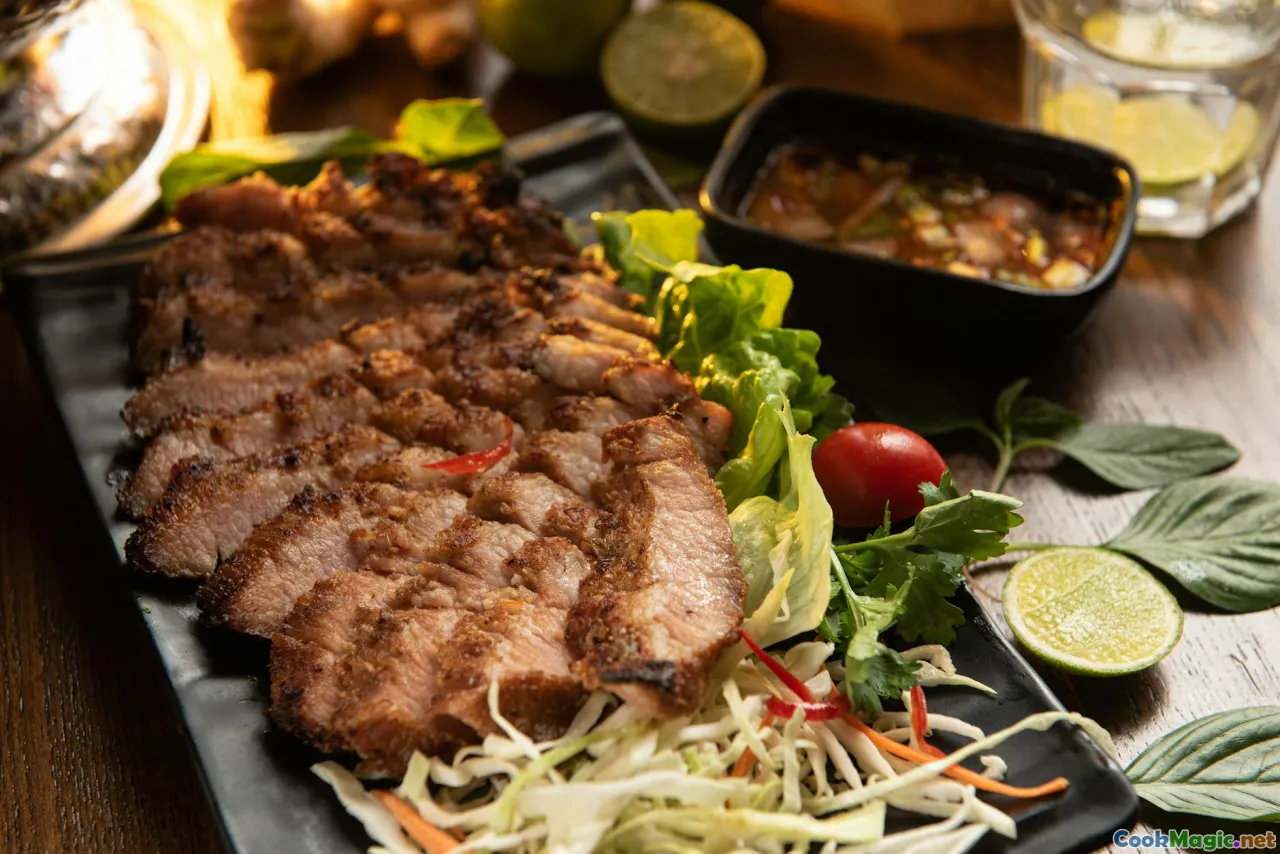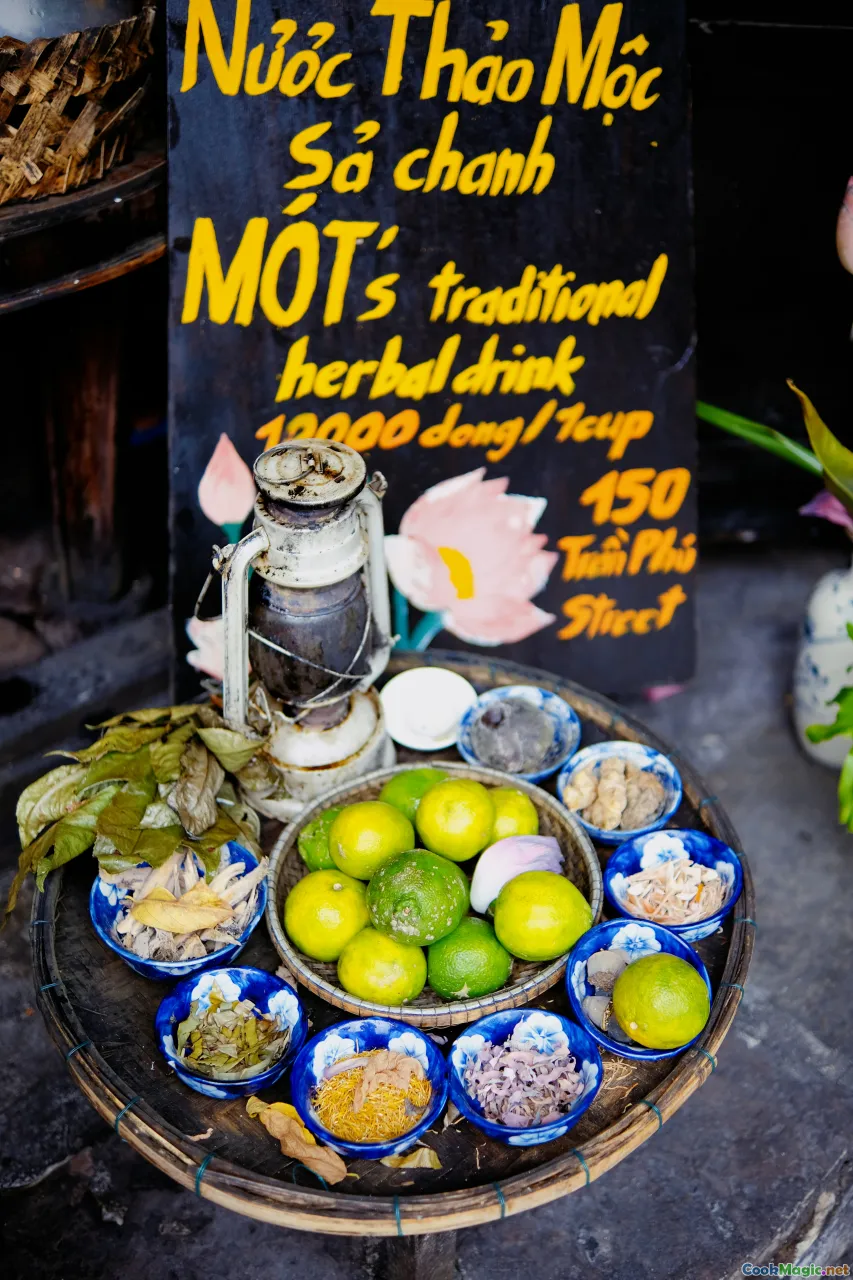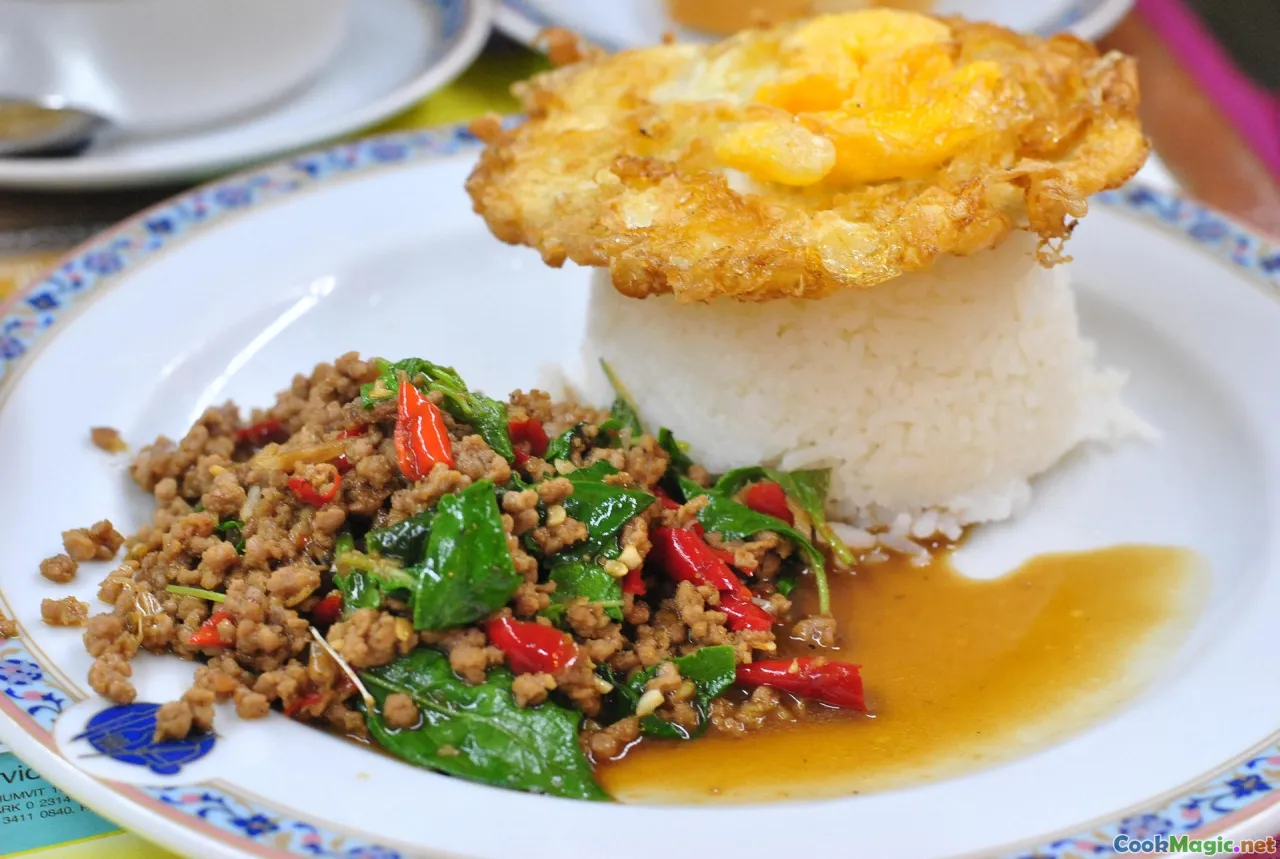
Свиный Ларб северо-таиландских горных племен с дикими травами
(Northern Thai Hilltribe Pork Larb with Wild Herbs)
(0 Обзоры)0
514
сентябрь 27, 2025
Сообщить о проблеме
Ингредиенты
-
250 grams Фарш из свинины
(Preferably from shoulder, well-marbled)
-
1 teaspoon Дикий сычуаньский перец
(Lightly toasted, or substitute regular Szechuan peppercorns)
-
1 tablespoon Сушеные хлопья красного перца чили
(Preferably Thai or local varieties)
-
2 small Лук-шалот
(Мелко нарезанный)
-
2 tablespoons Свежий Лимонный Сок
(From 1 large lime)
-
1.5 tablespoons Рыбный соус
(Или отрегулируйте по вкусу)
-
2 teaspoons Тостовая мука из клейкого риса
(Pan-toasted and ground; adds nutty texture)
-
1 bunch Свежий кориандр
(Roughly chopped, divided, stems preferred)
-
10 grams Листья мяты
(Roughly torn for freshness)
-
8 leaves Зубчатая трава (culantro)
(Sliced thin; substitute additional coriander if unavailable)
-
4 leaves Лист лайма макрут
(Midrib removed, finely slivered)
-
1 stalk Зеленый лук
(Finely sliced, green and white parts separated)
-
1 cm knob Галангаль
(Minced, provides subtle warmth)
-
30 grams Дикие собранные зеленые листья
(Watercress, wild betel leaf or arugula; adds bitterness)
-
1 pinch Соль
(По вкусу)
-
1 small Огурец
(Sliced, for serving)
-
160 grams липкий рис
(Soaked and steamed, served alongside larb)
(Preferably from shoulder, well-marbled)
(Lightly toasted, or substitute regular Szechuan peppercorns)
(Preferably Thai or local varieties)
(Мелко нарезанный)
(From 1 large lime)
(Или отрегулируйте по вкусу)
(Pan-toasted and ground; adds nutty texture)
(Roughly chopped, divided, stems preferred)
(Roughly torn for freshness)
(Sliced thin; substitute additional coriander if unavailable)
(Midrib removed, finely slivered)
(Finely sliced, green and white parts separated)
(Minced, provides subtle warmth)
(Watercress, wild betel leaf or arugula; adds bitterness)
(По вкусу)
(Sliced, for serving)
(Soaked and steamed, served alongside larb)
Питательная ценность
- Порции: 2
- Размер порции: 1 горка на тарелке (250 г)
- Calories: 430 kcal
- Carbohydrates: 38 g
- Protein: 25 g
- Fat: 20 g
- Fiber: 4 g
- Sugar: 4 g
- Sodium: 1050 mg
- Cholesterol: 65 mg
- Calcium: 66 mg
- Iron: 3 mg
Инструкции
-
1 - Prepare Fresh Ingredients:
Finely chop shallots, fresh herbs, and slice cucumber. Mince galangal if using, and slice wild greens. Set aside the greens you wish to reserve for garnishing.
-
2 - Toast Sticky Rice & Spices:
Dry-toast sticky rice, peppercorns, and (if using) galangal in a skillet over medium heat until aromatic and golden. Let cool, then grind into a rough powder.
-
3 - Cook the Ground Pork:
Heat a dry skillet or wok. Add the ground pork and stir-fry, breaking up any lumps, until just cooked through but still juicy. Salt lightly.
-
4 - Mix Aromatics:
With the pan off heat, add chopped shallot to the pork. Mix gently to soften slightly in residual heat.
-
5 - Combine Seasonings:
Transfer pork and shallots to a mixing bowl. Add fish sauce, lime juice, and chili flakes. Stir lightly to combine flavors.
-
6 - Fold In Herbs & Rice Powder:
Add toasted rice spice mix and most chopped herbs (saving some for garnish). Add half the sliced wild greens if using. Toss everything just until combined.
-
7 - Serve & Garnish:
Plate larb, topping with extra herbs and wild greens. Add fresh cucumber on the side and serve with sticky rice.
Finely chop shallots, fresh herbs, and slice cucumber. Mince galangal if using, and slice wild greens. Set aside the greens you wish to reserve for garnishing.
Dry-toast sticky rice, peppercorns, and (if using) galangal in a skillet over medium heat until aromatic and golden. Let cool, then grind into a rough powder.
Heat a dry skillet or wok. Add the ground pork and stir-fry, breaking up any lumps, until just cooked through but still juicy. Salt lightly.
With the pan off heat, add chopped shallot to the pork. Mix gently to soften slightly in residual heat.
Transfer pork and shallots to a mixing bowl. Add fish sauce, lime juice, and chili flakes. Stir lightly to combine flavors.
Add toasted rice spice mix and most chopped herbs (saving some for garnish). Add half the sliced wild greens if using. Toss everything just until combined.
Plate larb, topping with extra herbs and wild greens. Add fresh cucumber on the side and serve with sticky rice.
Подробнее о: Свиный Ларб северо-таиландских горных племен с дикими травами
Northern Hilltribe Pork Larb: Roots and Revelations from Thailand’s North
A Personal and Cultural Narrative
Larb, or "laap" as it might be spelled, is one of those touchstone dishes in Southeast Asian cuisine—with vibrant flavors of herbs, spices, and the energetic bounce of tangy, spicy pork. While Laos and northeast Thailand are often credited with popularizing larb, this dish takes its creative inspiration from the more mountainous regions of Northern Thailand, where ethnic Hilltribe communities—such as the Hmong, Lisu, Akha, and Karen—each have their own approach to seasonality, foraged foods, and fiery spice. Northern Hilltribe Pork Larb celebrates these highland palates: woody with toasted spices; alive with fresh, bitter herbs; earthy with foraged greens; brightened by local lime juice—all perfectly cradled in warm communal gatherings.
Uniqueness in Every Bite
What makes this northern version distinguish itself? First, it employs not just the usual mint and coriander, but also less-heard-of wild greens (like wild betel, watercress), and aromatics (culantro, galangal) that Hilltribes make daily use of in their foraged cuisines. Wild Szechuan peppercorn—different from the hot chile spice—brings an unusual tingling and an unexpected swelling warmth, reflecting indigenous spice traditions.
Another key aspect: the delightful crunch from toasted sticky rice powder—a technique originating in the hills, where sticky rice is diet-staple and used in everything from savory to sweet. Grinding this with toasted peppercorn and galangal deepens nutty, roasted notes and gives you texture that’s both aromatic and textural—something you’ll want to use for other recipes, too!
For Hilltribe cuisine, mixing cooked hot meat and raw, just-torn herbs is standard, rather than an anomaly. Layering cooked, juicy pork and immediately tossing it—still steaming—with aromatic herbs headily infuses the entire dish, unlike the often colder versions found in mainstream Thai restaurants.
Assembly Tips & Variations
- Ground pork from the shoulder (or a mix with just 20% fat) is quintessential for richness; try adding grilled crusty pork if desired for even more edge.
- Experiment with native or wild greens in your area—mustard cress, watercress, or arugula, for a nice, palate-freshening, bitter punch.
- Toasting sticky rice properly is essential: never skip letting it go nut brown, and always cool before grinding.
If you cannot find makrut lime leaves or galangal, use additional torn lemon grass or even grated lime zest.
Enjoying Your Larb
Traditionally, larb is eaten family-style, shared with sticky rice and a variety of local vegetables and greens. Authentic eating is with the fingers; form a small ball of sticky rice, use it to pick up tender morsels of larb and shoot everything back in one glorious bite. The type of stick-to-your-ribs happiness and the punch of flavor—the salty, spicy, tangy, and unashamedly herbal—are defining. Cucumber or raw green beans are often served alongside, to refresh and balance the heat.
Historical & Social Context
In Hilltribe tradition, laab isn’t simply a dish of sustenance—it’s essential to social hospitality, a marker of both daily life and times of celebration, pact-making, and community mourning. Pork especially is central to highland economies and ceremonies, often prepared fresh immediately after slaughter at markets or villages, and larb (sometimes made even from fresh blood or innards, though this recipe stays approachable) is a testament to utilizing every part with flavor-forward grace.
Closing Thoughts
Trying Northern Hilltribe Pork Larb puts you in touch with a vibrant yet deeply traditional cuisine. It’s rustic, but layered; earthy and spicy, but delicate with lime and herbs. You’ll be amazed at how quickly it comes together, how flexible those foraged bits can be, and how fresh, alive, and different it feels from the usual fare. Reminding you how cuisine can both preserve tradition and nourish creativity: a rare quality—much like the Northern hills themselves.

























